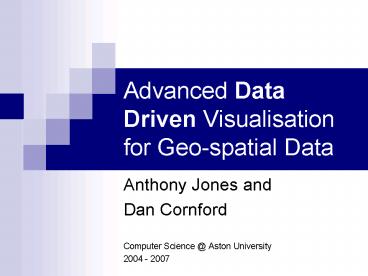Advanced Data Driven Visualisation for Geospatial Data - PowerPoint PPT Presentation
1 / 35
Title:
Advanced Data Driven Visualisation for Geospatial Data
Description:
... a reinvestment of both time and money. Example Abstract Change ... Application design, architecture, and content can be manipulated at high level of abstraction ... – PowerPoint PPT presentation
Number of Views:37
Avg rating:3.0/5.0
Title: Advanced Data Driven Visualisation for Geospatial Data
1
Advanced Data Driven Visualisation for
Geo-spatial Data
- Anthony Jones and
- Dan Cornford
- Computer Science _at_ Aston University
- 2004 - 2007
2
Motivation
3
Project Aims
- Main emphasis on producing flexible, extensible
software architectures - Focus on application development and subsequent
flexibility at high levels of abstraction - Visualisation as example problem domain and proof
of concept
4
Key Technologies
- Data Driven Programming (DDP)
- one clearly distinguishes code from the data
structures on which it acts, and designs both so
that one can make changes to the logic of the
program by editing not the code but the data
structure - Object Oriented Data Driven Programming (OODDP)
- Data drives the logical and behavioural
composition of a software architecture using
concepts available to the object oriented
programming paradigm
5
OODDP
6
OODDP
7
OODDP
8
OODDP
9
OODDP
10
Key Technologies
- Data Driven Programming
- Object-Oriented Data Driven Programming
- Plug-ins (and possibly scripting)
- Use data to drive logical and behavioural
composition of the software architecture - Push problem domain specifics into higher levels
of abstraction
11
Problem Domain
- Developing at a high level of abstraction
- Problem domain agnostic software architectures
- Changes at a high level of abstraction
- Abstract change
- Application capabilities
- Application content
12
Abstract change
- Changes are made at high levels of abstraction
- e.g. Requirements or software design
- Requires modification at lower levels of
abstraction - e.g. Program code or application resources
- Theres a (re)implementation gap in the middle
- Usually involves a reinvestment of both time and
money
13
Example Abstract Change
14
Application capabilities
- Modify or augment software capabilities
- To provide additional support for new input or
output devices - To provide change of visualisation or data
management methods - To provide implementation tailored to target
specific users or environments
15
Example Capability Change
16
Application content
- Manipulation of application content objects
- Visible resources (2D images and text, 3D models
and meshes) - Behavioural resources (scripts, routines, paths,
triggers) - Types and instances
- Manipulation
- Add, remove or modify the visible or behavioural
aspect of content object instances and types
17
Example Content Change
18
Our Solutions
- Developing at a high level of abstraction
- Generic application framework
- DDP and OODDP, plug-ins and scripting provide
high-level business logic layer
19
Generic Application Framework
- Core
- Subsystems
- Data
20
Generic Application Framework
- Core
- Abstraction of generic functionality
- No application
- Family of interfaces and communication objects
21
Generic Application Framework
- Subsystems
- Application specific
- Form application capabilities
- Implement core functionality as collection of
plug-ins - Interchangeable
22
Generic Application Framework
- Data
- Context specific
- Forms application content
- Provide concrete business logic for problem
domain - Provide parameterisation for application content
and subsystem implementations
23
Our Solutions
- Developing at a high level of abstraction
- Generic application framework
- DDP and OODDP, plug-ins and scripting provide
high-level business logic layer - Changes at a high level of abstraction
- Manipulation via DDP and OODDP, plugins and
scripting - All high-level stuff
24
Abstract change
- Changes are made at high levels of abstraction
- e.g. Requirements or software design
- Theres a direct mapping to an equivalent
framework concept - Everything above the framework core can be added,
modified or replaced to drive application
capabilities, content and behaviour
25
Abstract Change Solution
26
Abstract Change Solution
27
Application capabilities
- Modify or augment software capabilities
- Replace desktop subsystem implementation plug-in
28
Application capabilities
- Modify or augment software capabilities
- with simulator subsystem implementation plug-in
29
Application content
- Manipulation
- Add, remove or modify the visible or behavioural
aspect of content object instances and types - Manipulate parameterisation of data layer
30
Content Change Solution
31
Content Change Solution
32
Content Change Solution
33
Research Summary
- Introduces a flexible data driven programming
paradigm that - Empowers rapid application development at high
levels of abstraction - Responds well to change
- Closes the re-implementation gap between design
and implementation during software refactoring - Pays for maintenance up front
34
Research Summary
- Positive contributions
- Application design, architecture, and content can
be manipulated at high level of abstraction - Provides additional flexibility and extensibility
without the need to recompile or involve a
software engineer - Particularly suited to software with evolving
requirements and high data content - Drawbacks and limitations
- Introduces additional data management, parsing
and processing requirements - Defers implementation details to later stages in
the project?
35
Thank youfor listening































